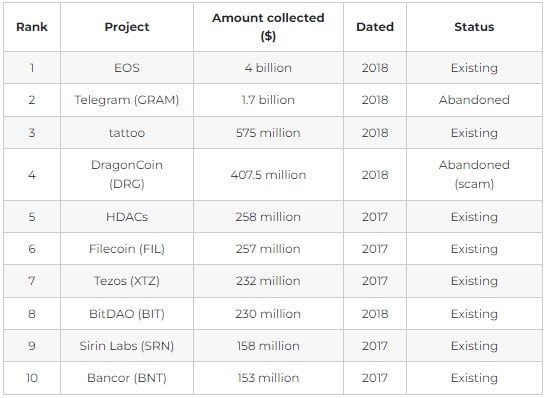Initial Coin Offering (ICO) has been attracting more and more investors for many years. Many of them have made significant gains by participating in some famous ICOs. A look back at the 10 biggest ICOs of all time and where they stand today
Largest cryptocurrency fundraisers
Here are the ICOs, crypto fundraisers, that have raised the most money. The article is from January 2022 and will be updated if any new ICOs raise more money.

What is an ICO?
An ICO or Initial Coin Offering is an operation to raise funds to finance a blockchain project. The company issues tokens that investors buy to finance the development of the project. The tokens will be used to operate the protocol, infrastructure or program in which one invests. They are valued or not depending on the evolution of the price of the crypto-currency.
This process is quite similar to the IPO or Initial Public Offering, found on the stock market, which gives companies the opportunity to build equity by selling their shares to investors. Some of the biggest names in the crypto-sphere have used this process to launch and continue their development. One example is Ethereum, which launched its ICO in 2014 with the success it is known for today. For the public, it is therefore a bet on the future and a way to get in early on a project that is considered promising.
In this article, we will look back at the 10 ICOs that have raised the most money in the history of cryptocurrencies.
The article does not mention the huge amount raised by LEO ($1 billion raised in 10 days), the token of the popular Bitfinex exchange, as these funds were raised through an IEO (Initial Exchange Offering) and not an ICO.
EOS: Largest ICO to date
EOS is a platform for developers to create decentralised applications (Dapps). The idea behind EOS is to make it as easy as possible for developers to program applications. EOS provides developers with a package of resources to easily understand blockchain technology.
Sold as an Ethereum killer, EOS has raised a whopping $4.1 billion. However, it has had multiple problems, ranging from fraudulent suspicions about its ICO, to the resignation of its co-founder Dan Larimer in January 2022. The token’s price collapsed in the aftermath by over 20%.
In fact, it is one of the losing cryptocurrencies of 2022, having fallen from 15th in terms of capitalisation to 50th, its price at the time of writing stands at around $3, a far cry from the $21 reached in 2018.

Telegram (GRAM): Messaging giant takes on cryptocurrencies
You probably know Telegram for its encrypted messaging service that competes with WhatsApp and Signal. The company raised more than $1.7 billion in a fundraising round in 2018. The Telegram Open Network (GRAM) project aimed to integrate blockchain-based payments directly into Telegram messaging.
What followed was less glorious as the US regulatory watchdog, the SEC, fined the company $18.5 million for failing to comply with securities laws. The company had to return the money raised from the ICO to the investors.
The idea was later taken up by the community under the name of The Open Network (TON), offering fast, cheap and user-friendly transactions. The token has grown significantly and is trading at around $3.50 in early 2022.

Tatatu: making money by watching movies
Tatatu made a big splash at its ICO in 2018 with over $575 million raised. This platform founded by Italian film producer Andrea Iervoino allows you to receive awards by watching films. There is also a social media, auction and e-commerce platform.
Users watch films and can collect TTU tokens that can be used throughout the ecosystem. However, unlike the vast majority of tokens, TTUs cannot be bought or sold on an exchange, only earned from the platform. Tatatu still exists, even if its actuality remains very limited at the moment.

DragonCoin: an online casino project that went wrong
The DragonCoin project was an initiative of Macau-based casino operator Dragon Corp. The company raised 320 million in a private pre-sale, with another 87.5 million raised in an ICO.
The Ethereum blockchain-based token was to be used as a currency to play in the group’s casinos. Unfortunately for investors, the project turned out to be a scam involving the Hong Kong mafia, so it was shelved.

HDAC: Hyundai subsidiary’s ICO
Hyundai Digital Asset Company, a subsidiary of the South Korean carmaker, launched an ICO in December 2017 for its HDAC cryptocurrency. This ICO raised $258 million, making it the 5th largest ICO of all time.
HDAC is a blockchain ecosystem related to IoT (the Internet of Things), but has so far failed to achieve the success it was hoping for. Indeed, after peaking at around $0.16 in September 2021, HDAC is trading at $0.03 in January 2022.
The project is not a total failure, however, as in March 2020 HDAC launched the first app on its main network and plans to launch a new ecosystem to compete with Klaytn, a consortium of blockchain platforms backed by the owner of the popular South Korean messaging app Kakao.

Filecoin: the proposed decentralized marketplace for data storage
Filecoin was created by Protocol Labs and the ICO for this project managed to raise $257 million in September 2017. This ICO aimed to fund the creation of a decentralised marketplace for data storage.
Filecoin was a highly anticipated project by the public, and despite numerous delays, it finally saw the light of day in October 2020.
The Filecoin token (FIL) was sold at $5 during the ICO. It has performed relatively well as its price has increased almost sixfold since then, trading at $28 in January 2022.

Tezos: one of the most successful ICOs
The Tezos Foundation, domiciled in Zug, Switzerland, raised $232 million in its 2017 ICO.
Tezos is a programmable blockchain with the ability to integrate smart contracts. Today, Tezos represents one of the most successful ICOs. Indeed, the return on investment has been particularly attractive (XTZ tokens were sold at $0.47 during the ICO) and the Tezos protocol has recently been selected for testing with the digital euro.
In addition, many features have been built into the Tezos protocol to attract the DeFi industry, and its XTZ token reached a record price of $12.19 in December 2017 and is trading in January 2022 at $4.

BitDao: a competitor to the NBB?
The BIT is the token from the BitDAO platform offered by the Bybit exchange. The platform, which specialises in cryptocurrency futures and ranks 11th in terms of overall trading volume, has seen strong growth since its inception in 2018.
BitDAO raised $230 million in its ICO. The BIT token offers the opportunity to have a role in the evolution of the BitDAO protocol. As a reminder, a DAO, for Decentralized Autonomous Organization, is an organization whose governance rules are written in a smart contract.
Here, the holders of BIT tokens have governance power over the protocol and its evolution. BIT holders can, for example, submit partnership ideas, vote on fee reductions on Bybit or block part of their tokens to participate in launches on the platform’s launchpad (project launch platform).
The aim of this DAO is to promote finance and the decentralised economy, but also to show the potential of DAOs as organisations. The price of the BIT token has now stabilised at around $2, close to its 2018 entry price.

Sirin Labs: the ICO linked to the world’s first crypto-smartphone
Sirin Labs, a startup located in Switzerland, raised $158 million in 2017 to fund its “blockchain phone” project, dubbed “Finney”, which featured an embedded crypto-currency wallet and a token called SRC. The SRC was primarily intended to power purchases through the decentralised Finney ecosystem app.
Sirin Labs delivered on its promises and the Finney project was launched in late 2018. Unfortunately, it was not a success and in April 2019, Sirin Labs laid off 25% of its workforce. Its founder, Moshe Hogeg, was also sued over an unpaid $6 million factory bill for manufacturing the famous phones.

Bancor: $153 million raised in 3 hours
In June 2017, Bancor, a project created in Switzerland, managed to raise the sum of $153 million within 3 hours. Famous investors such as Tim Draper and Blockchain Capital participated significantly in this ICO. The Bancor platform was designed to make it easier for users to launch their own tokens.
One year after this ICO, its token BNT has fallen heavily. Indeed, the platform suffered a hack and criminals stole $13.5 million worth of tokens from Bancor’s decentralised exchange (DEX) in 2018.
In 2019, the same platform was forced to ban US-based users due to regulatory uncertainty.
In recent months, DEX has benefited from the popularity of decentralised finance (DeFi), but the BNT token has never recovered its January 2018 historical price level of $10.72. Indeed, the BNT token is trading 4 years later (in January 2022) around $3.

Conclusion
ICOs represent relatively attractive opportunities for investors, but they also carry a significant amount of risk. Project study and thorough research are essential to minimise uncertainty and invest in the strongest ideas that will have the maximum chance of success in the future.
It should be remembered that large-scale projects such as Ethereum, Cardano, Tezos and Filecoin have used ICOs. They offered their investors a considerable return on investment in just a few years.
At the same time, between proven scams and projects that struggle to follow their initial roadmap, the choice of whether or not to participate in an ICO must be carefully considered. It is not uncommon to lose part of one’s investment, or even all of it in the case of a scam like DragonCoin.
